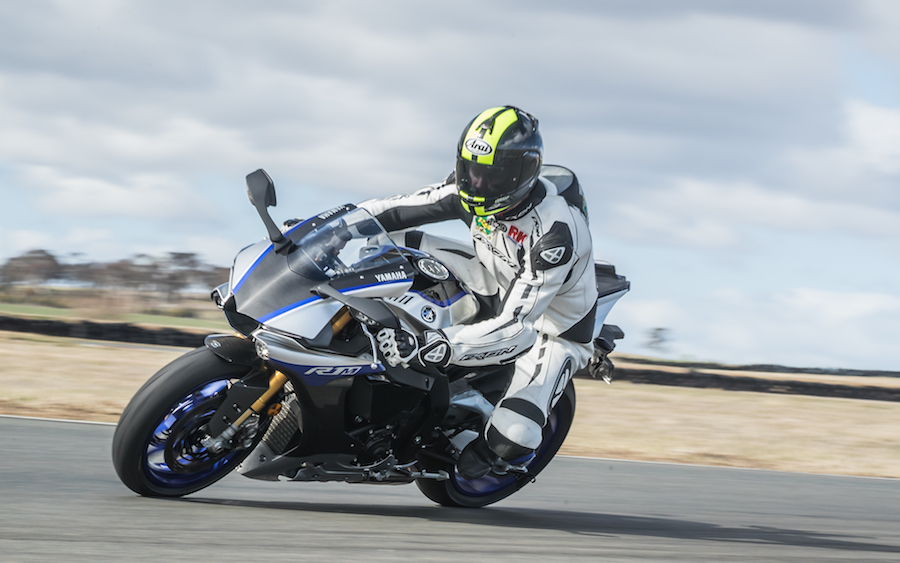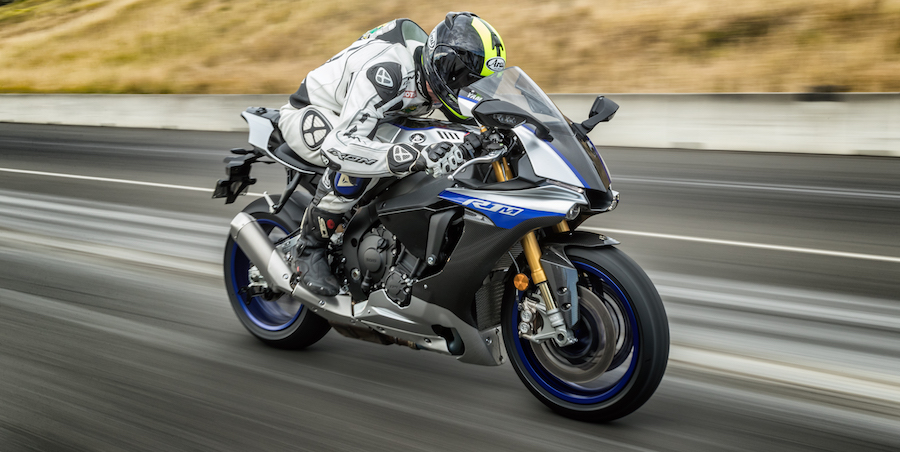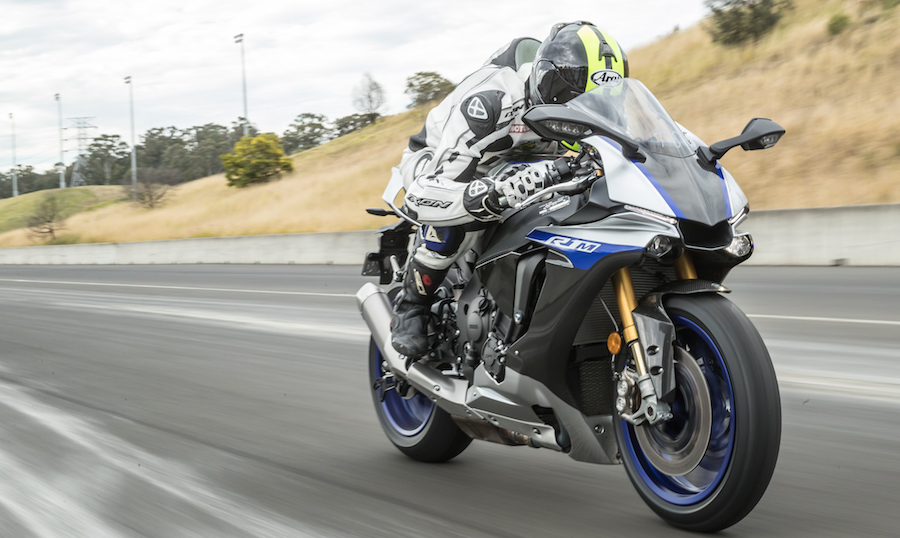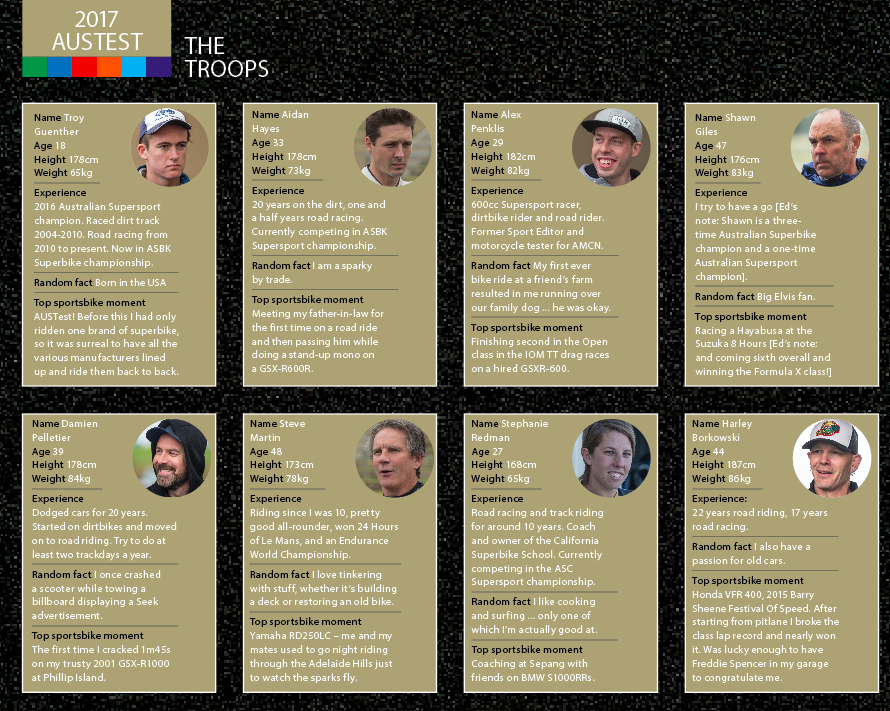It’s not often a Japanese bike creates a presence like the R1M does. Its immaculate finish and unique features created a storm when it burst onto the scene in 2015. The first bike fitted with a TFT dash and the first with a built-in GPS data recorder, it offered the user more electronic information than ever before, all accessible by wi-fi connection to an iPad. It had real carbon fairings and an Öhlins suspension package that was a massive improvement over the Kayaba kit on the base model. It was sure-footed, good-looking, and with its slimmer, lighter and more powerful second-generation big-bang engine it ruled the streets.
A couple of years down the track and the M is as beautiful as ever. Of the Japanese contingent, it’s the one that filled our riders with the most emotion – that explosive and unique growl from the cross-plane engine and the special pulsating vibe in the seat of your pants makes you feel like Rossi pulling into the pits every time you come to a stop.
It feels so linear in its power delivery with strong bottom-end grunt that builds to a steady crescendo right up to the redline. That fact was proved when the R1M passed through the drag strip traps with a top speed of 150.25mph (241.8km/h), one of only three bikes to crack the milestone.

The M’s not all noise, show and straight-line velocity though – its top-notch suspension and Yamaha race-inspired Deltabox frame should make it the perfect basis for any trackday rider or A-grade racer.
We know the M is fast around every circuit, with Wayne Maxwell winning many races and currently running at the front of the ASBK championship. So it was a shame none of the riders managed a lap time to reflect that on the day – probably due to the cold temperatures not working with the Bridgestones.
Although the Yamaha was the only bike on test without Brembos fitted, the group agreed that Yamaha’s Advics brake calipers are some of the best anchors in the business. They gave good feel and stopping power with no hint of fading.
The electronics were probably the most advanced of the Japanese bikes with a silky-smooth throttle feeling and traction control that worked well and non-intrusively, controlling the extra spinning encountered with the worn rear tyre in the afternoon sessions. It’s also the only bike fitted with slide control, a system straight from Yamaha’s MotoGP R&D department. It was only introduced into the GP scene in 2013, so to get it into production so soon shows how seriously Yamaha wants this bike to dominate its class.
The M’s looks and ground-breaking technology have held it in good stead, but the competition is coming. For $31,999 (+ ORC) the team agreed it needs a bi-directional shift system like the competition, but they also said if one turned up in your shed you wouldn’t kick it out.
Once it was the kind of cutting-edge technology you’d find only on MotoGP and WSBK bikes; now electronic assist systems and dynamic suspension are the rule for all big-bore production superbikes, not the exception.
In our last AUSTest, back in 2015, we celebrated the rebirth of the superbike, when the world’s top manufacturers pulled themselves out of the GFC doldrums and got back to work creating proper one-litre speed machines. Bugger the cost, and bugger the practicality they said.

Two years later, the world’s fastest and most desirable machines have morphed once more. With big-bore nakedbikes becoming the machine of choice for the regular rider wanting usable power, handling and looks in a package they can live with day to day, production superbikes have become the Ferraris and Lamborghinis of the motorcycling world. Crammed full of power, performance and electronics few will ever fully test, and riding on a suspension package that can adjust itself on the fly, these machines are gorgeous examples of what is possible, yet are impractical for the road – and that’s why we love them.
In another first for AUSTest, every bike tested this year sits well over the $20,000 mark. If your five-figure budget begins with a 1, you are out of luck. All that technology comes at a cost, but as you are about to discover, a higher price mostly offers better value for money.
While the evolution of the superbike has continued unabated, one thing returning to the way of old is how we conduct AUSTest. For 2017, we were back in NSW and invited manufacturers to be hands on, requesting each deliver their bike accompanied by a factory-trained technician to help our test riders find the best possible set-up. Such is the high regard the manufacturers have for the AUSTest title, most sent multiple staff and the show looked more like a round of the ASBK than a shootout. That’s fitting, considering our AUSTest combatants often go head to head on the track.
In the end, there can be only one winner, and over the next 26 pages we will take you through the exhausting testing process. Then, when you think you have the winner sussed, we will reveal our champion. Enjoy the ride – we certainly did.

Three Things
- The R1M was the first production sportsbike to come fitted with a TFT dash
- The sound of the R1M’s big-bang engine coming through that titanium exhaust had all our test riders mesmerised
- That’s right, real carbon fibre adorns the R1M, giving it that extra touch of class

Harley from RB Racing says…
The growl the R1M produces is awesome, and sets the R1M apart from the other in-line fours on test. The torque is a little weak up to 7000rpm, but from that point there is a massive rush all the way to the revlimiter, so you’ll need to keep the revs up to get the most out of it. The transmission is smooth and positive, but it’s the only bike on the test without an auto down shifter. The fuelling has a few rich spots throughout the rev range, and it could really benefit from a good tune.


Second ops
Troy Guenther
I loved the sound and overall look. The fact that the exhaust was tuned to a certain note from the Yamaha music department was intriguing, and it made an awesome noise. The carbon detailing throughout the aerodynamic fairing gave it a sleek, professional and racey look I really admired. It also had good power down low, which was especially prevalent when doing the starts at the drag strip.

Price
$31,999
Power
132.49kW
Torque
105.03Nm
2017 AMCN AUSTest

Day 1
Sydney Dragway
It’s a known fact that there’s no quicker way to get away from the lights than to use a machine producing in excess of 130kW and weighing just 200kg. Now, imagine a set of traffic lights where you don’t need to shut the throttle before changing to second gear and obliterating the speed limit. Such a place exists at Western Sydney. With a surface as sticky as shit on a blanket, and electronic timing with reaction times and speed traps, it’s a quarter mile of international-standard heaven that hosts some of the fastest drag bikes and cars in the world.
We lined our six AUSTest combatants up two at a time to test their launch and wheelie control, and of course, to see which could cover the quarter mile distance in the quickest time at the fastest speed. Before getting underway, those in the know said that a low 10-second pass would be impressive.
What eventuated left the experts gobsmacked.
Day 2
Wakefield Park Raceway, Goulburn
A regular stop on the ASBK circuit, Wakefield Park is tight and technical – an evil-handling bike will quickly be found out on the undulating 2.2km circuit. Throw in strong winds and unpredictable weather, and you need to be on the ball.
For a full day we rotated the six AUSTest bikes through the hands of the eight track-test riders. As conditions improved, and the technicians fine-tuned the bikes, the lap times began to drop. While there are no AUSTest points on offer for the fastest lap, there are definitely bragging rights, and everyone wanted them.
We won’t spoil the surprise, but we will say that the lap times set would have seen our stock-standard AUSTest entrants line up mid-grid at an ASBK round. Impressive stuff.
Day 3
Road ride, Goulburn to Sydney
The chosen route was 400km-plus of tight twisty and open country road special stages connected by freeway hops, all packed into a non-stop day. This provided the riders with a chance to sample each bike in the environment where it will be most used. An uncomfortable seating position or snatchy fuelling will always be revealed on a road ride. AUSTest titles have been won and lost in this section of the test.
Day 4
On the dyno
Are the claimed numbers bullshit? There is only one way to find out: with a dyno.
Our final destination for AUSTest 2017 was RB Racing at Caringbah where Harley Borkowski ran each of the bikes on the dynamometer to measure kW and Nm output. Harley was also one of our test riders this year, giving him the unique opportunity to see if the dyno numbers correlated to what the seat of his pants said.
THE METHOD
Who buys a superbike? A snapshot of the current superbike buying public will reveal possibly one of the widest demographics of any genre. Everyone from riders graduating from a restricted licence through to those who have worked long and hard enough to afford a few luxuries in life are buying superbikes. Highly skilled riders and racers buy them, as well as people who just want to look like Messrs Márquez, Rossi and Lorenzo at the local café – and drool over what a production superbike has to offer. AUSTest is as much about real-world performance and looks as it is about race pedigree and lap times, so we assembled a group of riders that represent the broad spectrum of superbike buyers. Daily riders, trackday junkies, endurance champs, national-title winners, professional test riders and young guns presently contesting the national Superbike and Supersport categories all made up the eight-rider test team charged with the task of determining who made the best two-wheeled missile for the best price.
Each rider was given two sessions on each bike on the drag strip, track and the road. Then they were handed an extensive voting form covering everything from how the bike performed and how it made them feel, through to value for money and which bike simply did it for you – regardless
of the cost.
While quarter-mile sprint and track lap times provided an indication of performance as well as plenty of entertainment and all-important bragging rights, it’s the results from the points-based voting sheets that determined the AUSTest 2017 champion.
Tyres
In years past we have experimented with a control tyre for AUSTest. While the idea works in theory, in reality most manufacturers have a commercial agreement with a tyre manufacturer, and the bike is developed using those tyres. If you are a superbike owner keen to cut some serious laps at a trackday, you will be faced with a few brand and rubber compound choices. To simulate a real-world situation, we left tyre choice to the manufacturers. As long as the tyre was DOT approved and available in Australia it was good to go.
Each manufacturer’s choice of tyre for AUSTest is provided on the test results. Most used just the one set of tyres for the drag strip and trackday, reverting to the OEM tyres for the road ride.
Timing
Each bike’s best quarter-mile time and top speed, as well as its fastest lap time on the track, do not form part of the voting criteria for AUSTest 2017, so this information is irrelevant – said no sane motorcycle lover ever. The minute the first bike shot down the quarter mile at Sydney Dragway or turned the first lap at Wakefield Park, everyone had their stopwatch out.
Sydney Dragway has its own timing system, but for Wakefield Park we needed something reliable, easy to install and easy to understand, that provided results instantly. The SpeedAngle lap timer ticked all these boxes. The team from SpeedAngle provided a unit for each bike, and even programmed the name of each model into the system so there could be no mix-ups. All six units performed faultlessly throughout the day, capturing every lap of every session.












